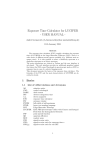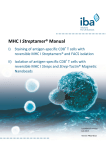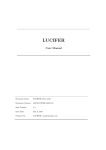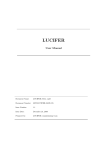Download Exposure Time Calculator for LUCI - USER MANUAL -
Transcript
Exposure Time Calculator for LUCI - USER MANUAL Andr´e Germeroth (A.Germeroth(at)lsw.uni-heidelberg.de) 15th July 2014 Abstract The exposure time calculator (ETC) roughly calculates the exposure time of LUCI at the Large Binocular Telescope (LBT). There is a wide choice of different model spectra available (e.g. different main sequence stars). It is also possible to select a blackbody spectrum or a single-line spectrum as an object spectrum. The main calculations are written in Python and the user interface is web-based. The web interface provides an additional graphical output that shows the SNR versus Wavelength in spectroscopic mode or SNR vs. exposure time in case of a selected imaging mode. This document presents the basics of the exposure time calculator. The formulae of the ETC and the main characteristics of LUCI are described in detail. 1 1.1 Basics List of Abbreviations and Acronyms AO CWL DARK DIT e.m. ETC EW FWHM HTML LBT LUCIFER/LUCI PSF QE RON SNR SNRτ SNRDIT adaptive optics central wavelength dark current detector integration time electro magnetic exposure time calculator entrance window full-width at half-maximum hyper text markup language Large Binocular Telescope LBT NIR Spectroscopic Utility with Camera and Integral Field Unit for Extragalactic Research point spread function quantum efficiency readout noise signal-to-noise ratio signal-to-noise ratio for exposure time τ signal-to-noise ratio for one DIT 1 1.2 1.2.1 The Exposure-Time-Calculator The Formulae This program will be used by observers for scheduling their observations with LUCI. The following fixed parameters • telescope (transmission, light-collecting area, reflectivity, . . . ) • transmission of the instruments (entrance window, lenses, . . . ) • quantum efficiency (QE) of the detector and user-defined parameters • object (geometry, spectrum, magnitude) • camera (scale) • filter • grating, slit width (spectroscopic mode) • atmospheric conditions (airmass, water vapor, sky background, seeing) • adaptive optics (is loop closed, Strehl ratio) • exposure parameters (detector integration time, total exposure time) • signal-to-noise ratio are used to calculate two auxiliary values: E F F0 : mag QE Tatm Ttel Tinst Tfilt : : : : : : = = Tatm · Ttel · Tinst · Tfilt · QE F0 · 10 − mag 2.5 (1) (2) flux density for Vega at λ = 550 nm F0 = 3.56 · 10−11 m2W ·nm [FLUX95] magnitude of the object quantum efficiency of the detector transmission of the atmosphere transmission of the telescope transmission of the instrument (without any filter and grating) transmission of the filter used The number of photons that are detected per second can be calculated with (1), (2) and the following formula [ESO-HP]: 2 Table 1: Formulae for calculating the number of photons from the source Observing mode Imaging Spectroscopy N P S τ : : : : point source N τ N τ = = extended source F·∆i ·E·S P F·∆s ·E·S P number of photons energy of one photon light-collecting area exposure time ∆i ∆s Ωi Ωs N τ N τ : : : : = = F·∆i ·E·S·Ωi P F·∆s ·E·S·Ωs P filter band width spectral resolution scale in imaging mode scale in spectroscopy mode In the near-infrared regime the SNR for the exposure time DIT is given by the formula: SNRDIT = q NDIT NDIT + npix · Nsky + DARKDIT + RON2 (3) DARKDIT : dark current for 1 DIT npix : number of integration pixels1 Nsky : sky signal for 1 DIT RON : readout noise SNRDIT : signal-to-noise ratio for 1 DIT In imaging mode the user will be asked for the signal-to-noise ratio for the exposure time τ (SN Rτ ). The ETC calculates the necessary exposure time to achieve this SN Rτ (see also formula 3): p τ = NDIT · DIT and SNRτ = SNRDIT · NDIT (4) 2 SNRτ →τ = · DIT (5) SNRDIT τ DIT NDIT SNRτ SNRDIT SNR 1.2.2 : : : : : : total exposure time detector integration time number of detector integrations signal-to-noise ratio for exposure time τ signal-to-noise ratio for one DIT signal-to-noise ratio for an exposure time of 1 sec The Telescope Mirrors Both LUCI instruments are going to be first-light instruments for the Large Binocular Telescope (LBT) at the bent Gregorian foci. This means, that the 1 In imaging mode npix of a point source is calculated within a 2 FWHM diameter aperture: 2 npix = π seeing . In spectroscopic mode the program uses npix = 2· seeing . For an extended scale scale source npix is set to 1 for both dimensions of the source. 3 light is reflected three times before entering the cryostats. If we optimistically assume a reflectivity of 90 % for each mirror, we get a total efficiency of 0.729 at the bent Gregorian foci. Adaptive Optics (AO) The LBT will provide a deformable secondary mirror for AO observations. For this reason the ETC can handle both a seeing-limited PSF and a diffractionlimited PSF (1.2.3). If the loop is closed, different Strehl ratios are possible. This depends on the environmental conditions (seeing, ...). Therefore the value of this parameter is continously changeable. 1.2.3 Point-Spread-Function Diffraction Limited Mode In diffraction limited mode with adaptive optics the PSF is approximately composed of two functions: 1. The core: This is an airy function of the telescope IAiry (r) ∼ D µ Bessel : : : D2 λ2 2 · Bessel(x) x 2 (6) diameter of the telescope mirror observing wavelength the the first kind Bessel function of the order 1. 2. The halo: It is given by a Moffat function β−1 IMoffat (r) = Iα,β (r) = πα2 Iα,β (r) α β r F W HM : : : : : r2 1+ 2 α −β (7) Intensity at the distance r with parameters α and β Parameter is used to fix the FWHM for a given β Parameter to fix the amountpof light in the lobes Distance to the center (r = x2 + y 2 ) √ 2α 21/β − 1 An example of such combined PSF is shown in Figure 1. For comparing the peak intensity of an ideal diffraction-limited optical system with a real system the Strehl parameter was introduced. Strehl = I obs I theo (8) This parameter is the ratio of the observed peak intensity at the detection plane of a telescope or other imaging system from a point source compared to the theoretical maximum peak intensity of a perfect imaging system working at the diffraction limit. For calculating the fraction of the halo and core component to achieve a certain strehl ratio the parameter F0 is introduced in this ETC. It has to fulfill the following equation: 4 12 Intensity in arbitrary units airy function moffat function 10 8 6 core 4 2 halo 0 -0.4 -0.3 -0.2 -0.1 0.0 arcsec 0.1 0.2 0.3 0.4 Figure 1: Simplified description of an observed AO-PSF: It is built by a core (Airy function) and a halo (Moffat function). Strehl = → F0 = I obs F 0 · IAiry (0) + (1 − F 0) · IMoffat (0) = I theo IAiry (0) IMoffat (0) − Strehl · IAiry (0) IMoffat (0) − IAiry (0) (9) (10) (11) In this mode the SNR is calculated for a disk with a radius of twice the radius of the airy disk. Seeing Limited Mode The PSF in this mode is approximated by a Gaussian-shaped function. In this case the seeing is the FWHM of this function and the SNR is calculated for a disk with a radius of the seeing. 1.2.4 Objects Besides the choice of the source’s size (point source or extended source) the observer can select one out of three different types of spectra: 1. Model spectrum (stellar, galaxy or uniform template) 2. Blackbody spectrum 3. Gaussian-shaped emission line In imaging mode the stepping of the spectra is 0.5 nm. This stepping is adjusted to the spectral resolution in spectroscopic mode. 5 Template Spectra 6 different model spectra representing various main sequence stars are available. These are [STERNS]: B0V, A0V, F0V, G0V, K0V, M0V (Figure 2). Their flux densities are normalized to f(λ = 550 nm) = 3.66 · 10−11 W m−2 nm−1 (12) In addition, 4 different galaxy template spectra are available (Figure 3 and [GALAXS]). If a spectrum is allowed to be redshifted the filename must include the phrase ’galaxy’ at any position. The transformed spectra are calculated by the definition of the redshift: z= λ − λ0 → λ = (z + 1)λ0 λ0 (13) z : redshift λ : measured wavelength λ0 : rest wavelength Finally, a uniform spectrum can be used. The first step of creating such a spectrum (constant flux density for all wavelengths) is to calculate the total flux (in the given band-pass) for a uniform spectrum with an arbitrary flux density. After that the flux is calibrated to the target magnitude given by the user. Blackbody Radiation The blackbody spectrum is another option that can be chosen. The flux density is calculated as a function of wavelength (14) for the user-defined temperature (T ). 1 f (λ) ∝ λ5 h c k TBB : : : : · exp hc kλTBB (14) −1 Planck’s constant h = 6, 62607 · 10−34 Js velocity of light c = 2.9983 · 108 ms Boltzmann’s constant k = 1, 3807 · 10−23 Blackbody temperature J s After that calculation the flux is normalized to the magnitude given by the user. Gaussian-Shaped Emission Line The last selectable standard spectrum is a gaussian-shaped emission line. The parameters are: central wavelength, FWHM and total flux. The magnitude of the source is not a free parameter anymore due to the total flux given by the user: (λ−Γ)2 1 (15) f (λ) = FLUX · √ · e− 2σ2 σ 2π σ is given by FWHM/2.35, FLUX the total flux and Γ the central wavelength. 1.2.5 Target Magnitude The input of the source magnitude (available for template spectra or blackbody only) have to be done in Vega magnitudes. 6 Flux density / [W/m2/nm] 6e-11 A0V B0V F0V G0V K0V M0V 5e-11 4e-11 3e-11 2e-11 1e-11 0 0.8 1 1.2 1.4 1.6 1.8 2 2.2 2.4 Wavelength / µm Figure 2: The six available stellar spectra Flux density / arbitrary units 3 E0 Sa Sb Sc 2.5 2 1.5 1 0.5 0 0.5 1 1.5 2 2.5 Wavelength / µm Figure 3: The four available galaxy spectra at redshift z=0. 7 1.2.6 Entrance Window LUCI is equipped with an entrance window tilted by 15◦ . It reflects the visible light to a wavefront sensor. Two different coatings are available. The main parameters are listed in Tab 2 while the plots can be found in Appendix EEntrance Windowsappendix.E: Table 2: Available entrance windows Window #1 Window #2 50% cut on 882 nm 955 nm transmission at 532 nm 0.42% 0.12% 1.2.7 Filter LUCI’s ETC uses transmission data of all filters measured by the manufacturer [BARR]. The additional numbers are the identifiers for the filters. They are stored in wavelength steps of 0.5 nm as well as the previous wavelengthdependent datasets. The transmission curves of these broadband filters are shown in Figure 4. All available filters (including the narrowband filters) are shown in Appendix CFilter Curvesappendix.C. 100 Transmission / % 80 60 40 20 0 0.80 1.20 1.60 2.00 Wavelength / µm z J H K 2.40 Ks OrderSep Figure 4: Broadband filters used by LUCI The optical filters U, B, V, R and I can be chosen for the input of the object’s magnitude only. They are originally described in steps of 10 nm (U) and 20 nm (B, V, R and I) [FIL-HP]. By linear interpolation the sampling was increased to 0.5 nm. 1.2.8 Cameras Three different cameras can be used with LUCI. The collimator lenses, mirrors and each camera results in three total efficiencies for each camera. These values 8 are shown in Table 3. One can read off the efficiency of each optical element in [ACC-RE]. Table 3: Efficiencies of the system camera and collimator in different wavelength regimes Camera N1.8 N3.75 N30 (zJ with ADC) z 0.49 0.57 0.37 J 0.52 0.63 0.43 H 0.57 0.68 0.63 K 0.61 0.73 0.68 The image scale of each camera is listed in Tab. 4. Table 4: Image scale of each camera Camera N1.8 N3.75 N30 (zJ with ADC) 1.2.9 Scale [”/pix] 0.25 0.12 0.015 LUCI 1 and LUCI 2 Both instruments are identical, their detectors, however, have different efficiencies. The efficiency curves are shown in Fig. 5 LUCIFER 1 LUCIFER 2 1.0 Efficiency 0.8 0.6 0.4 0.2 0.0 0.8 1.0 1.2 1.4 1.6 1.8 2.0 2.2 2.4 Wavelength / µm Figure 5: The efficiency of the two LUCI detectors versus the wavelength. The different detectors are color coded. 1.2.10 Gratings Three gratings are installed in LUCI. All of them were tested for their efficiencies by the manufacturer. The company measured in a Littrow setup. LUCI reaches 9 about 90% ([FDR-OP]) of the nominal efficiencies because it is not working under Littrow conditions. See Appendix DGratingsappendix.D for the plots and ASCII-files. • High-Dispersion grating (HD-grating) with 210 l/mm. • H+K-grating with 200 l/mm • Ks-grating with 150 l/mm 1.2.11 Water vapor in the Atmosphere The water vapor in the atmosphere is the main reason for absorbing light in the near-infrared and infrared. The transmission of light for three different watervapor levels in the wavelength range from 0.9 µm to 2.5 µm is shown in Figure 6. The transmittance of the atmosphere for 1 mm, 1.6 mm and 3 mm water vapor [TRANSA] is displayed. In the ETC three different values for the water vapor can be selected: 1.0 mm, 1.6 mm and 3.0 mm. 1.0 Air transmittance 0.8 0.6 0.4 0.2 0.0 1.0 1.2 1.4 1.6 1.8 2.0 2.2 2.4 Wavelength/µm Figure 6: Transmittance vs. wavelength for three different water vapor levels. 1.2.12 Airmass The airmass is an additional parameter which influences the transmission. The ETC allows six different values for the airmass: 1.00; 1.25; 1.50; 1.75; 2.0; 2.5 The Airmass (AM) scales the number of photons from the sky background with −2.78719·10−4 ·AM 3 −6.53841·10−2 ·AM 2 +1.11979·AM −5.52132·10−2 (16) It is a polynomial fit to observed sky brightnesses from [SKYREF]. For small zenith distances (< 40◦ ) it is similar to the van-Rhijn’s function (formula 17). 10 1.2.13 Sky Background The sky background in near-infrared regime can rapidly change within hours or even minutes. For that reason the observer can choose between three different possibilities of sky background templates.. Sky Brightness given by the User The observer can set a brightness of the sky in mag(VEGA) for the zenith. It arcsec is the brightness of the sky for the filter used for the observation. Background File Another option is a file. This file contains data from sky background measurements at Mauna Kea for 1.6 mm water vapor and the selected airmass (see Fig. 7). 600 Photons/sec/nm/arcsec2/m2 1.6 mm H2O, Airmass=1.5 500 400 300 200 100 0 0.8 1 1.2 1.4 1.6 1.8 2 2.2 2.4 Wavelength/µm Figure 7: Sky spectrum measured at Mauna Kea for 1.6 mm water vapor and an Airmass of 1.5 [SKYBA] Theoretical Background Spectrum A theoretical spectrum is the last possibility for choosing a sky background. This spectrum is shown in Figure 8. The fundamental parts of this calculation are the OH-line database [OH-LIN, ROUS00] and the transmission data of the atmosphere [AIRTRA]. The ratio of intensities for two lines may change during the night or from observation to observation. This is the reason why it is possibile to change the relative intensities via an ini-file. The predefined values are adjusted to Mauna Kea’s night sky spectrum [SKYBA]. For modeling the sky background, we assume: • OH-line absorption due to the light travel through the atmosphere, scaled with T • thermal emission of a blackbody with a temperature of 250 K, scaled with (1-T) 11 900 1.6 mm H2O, Airmass=1.5 Photons/sec/nm/arcsec2/m2 800 700 600 500 400 300 200 100 0 0.8 1 1.2 1.4 1.6 1.8 2 2.2 2.4 Wavelength/µm Figure 8: A synthetic spectrum of the sky background • zodiacal emission (a blackbody spectrum; T=5800 K) • increasing intensity with larger zenith distances (described by the vanRhijn’s function) Then the sky background can be described as: Nsky = Nsky T OH BBx R h z 1.2.14 : : : : : : : T · OH + (1 − T) · BB250 K + BB5800 K s 2 R 1 − R+h · sin2 z (17) number of photons from sky background transmission of the atmosphere intensity of the OH-line blackbody with a temperature x earth radius (∼ 6378 km) hight of emitting layer (∼ 100 km) zenith distance Slit Width and Slit Transmission Slit Width Different slit widths between 0.25” and 2.00” can be selected. If the width is smaller than the scale of the camera used the width is set to the scale of the camera. Slit Transmission First of all the program calculates the number of photons reaching the slit. After that it computes the number of photons behind the slit. For a point-like source it assumes a PSF like a Gaussian or a Moffat + Airy disc. The hatched area in Figure 9 is the relevant area for transmission. The transmitted photons are split into the pixels 1 - 5 (see bottom of Figure 9). For example: if 18 photons 12 are passing the hatched area of the slit, the light will be split up to 4.5 pixels. Pixel 1, 2, 3 and 4 will detect 4 (18/4.5=4) photons each. The fifth pixel will count 2 photons. Figure 9: Top: Sketch of a slit. The hatched area is used to calculate the transmission of the slit. The parameter d depends on the observing mode. For seeing-limited mode it is the FWHM of the seeing. In diffraction-limited mode it is the diameter of the first minimum of the airy disk. Bottom: The calculated photons are split into the shaded pixels. 13 References [ESO-HP] Exposure Time Calculators - Formular Book : http://www.eso.org/observing/etc/doc/gen/formulaBook/ [FLUX95] C. M´egessier Astronomy and Astrophysics, 296, 771-778, (1995) [OH-LIN] http://www.eso.org/instruments/isaac/oh/list_v2.0.dat [ROUS00] P. Rousselot, C. Lidman, J.-G. Cuby, G. Moreels, G. Monnet Astronomy and Astrophysics, 354, 1134-1150, (2000) [SKYBA] http://www.gemini.edu/sciops/ObsProcess/obsConstraints/atm-models/ nearIR_skybg_16_15.dat [AIRTRA] http://unagi.gps.caltech.edu/notes/bfats2002/ [STERNS] A. J. Pickles Publications of the Astronomical Society of the Pacific, 110, 863-878, (1998) [GALAXS] J. Bicker, U. Fritze, C. S. Muller, K. J. Fricke astro-ph/0309688 [FIL-HP] http://obswww.unige.ch/gcpd/filters/fil08.html [FIL-PA] H. L. Johnson Astrophysical Journal 141, 923-942 (1965) [FDR-OP] W. Seifert, W. Xu LUCIFER, Final Design Report Optics, LBT-LUCIFER-TRE-009 [ACC-RE] N. Ageorges, A. Germeroth, W. Seifert, Acceptance Test Report, LBT-LUCIFER-TRE-022 [TRANSA] http://unagi.gps.caltech.edu/notes/bfats2002/ [GRATIN] Richardson Grating Laboratory http://www.gratinglab.com [BARR] Barr Assosiates Inc. http://barrassociates.com [SKYREF] C. Leinert et al., Astronomy and Astrophysics Supplement, 127, 1-99, (1998) 14 A Filter Curves z filter J filter #3002 ED034-2 1.00 0.8 Transmission 0.80 Transmission #0403 ED044 1.0 0.60 0.40 0.20 0.6 0.4 0.2 0.00 0.80 0.0 0.85 0.90 0.95 1.00 1.05 1.10 1.0 1.1 Wavelength / µm 1.2 H filter Transmission 0.8 0.6 0.4 0.2 0.6 0.4 0.2 0.0 0.0 1.4 1.5 1.6 1.7 1.8 1.9 Wavelength / µm 1.9 2.0 2.1 2.2 2.3 Wavelength / µm Ks filter #3902 ED046-1 1.0 0.8 Transmission 1.5 #3902 ED059 1.0 0.8 Transmission 1.4 K filter #4302 ED024 1.0 1.3 Wavelength / µm 0.6 0.4 0.2 0.0 1.9 2.0 2.1 2.2 2.3 2.4 Wavelength / µm Figure 10: Filter curves of broad-band filters (Part 1) 15 2.4 2.5 HKspec Filter zJSpec Filter ED763-1 ED763-2 1.00 0.80 Transmission Transmission 0.80 0.60 0.40 0.20 0.00 1.20 60030 1.00 0.60 0.40 0.20 1.40 1.60 1.80 2.00 2.20 2.40 2.60 2.80 Wavelength / µm 0.00 0.80 1.00 1.20 1.40 1.60 Wavelength / µm Figure 11: Filter curves of broad-band filters (Part 2) 16 1.80 2.00 Brackett-γ filter FeII filter ED477-1 ED477-2 1.00 0.80 Transmission Transmission 0.80 0.60 0.40 0.20 0.00 2.14 ED468-1 ED468-2 1.00 0.60 0.40 0.20 0.00 2.15 2.16 2.17 2.18 2.19 2.20 1.62 1.63 Wavelength / µm 1.64 H2 filter HeI 1085-15 0.80 Transmission Transmission 1.67 1.00 0.80 0.60 0.40 0.20 0.60 0.40 0.20 0.00 2.08 2.10 2.12 2.14 2.16 0.00 1.05 2.18 1.06 Wavelength / µm 1.08 1.09 1.10 1.11 OH filters J-low J-high 1.00 1.07 Wavelength / µm J-low and J-high filter OH-1060 OH-1190 1.00 0.80 Transmission 0.80 Transmission 1.66 HeI filter ED469-1 ED469-2 1.00 1.65 Wavelength / µm 0.60 0.40 0.20 0.60 0.40 0.20 0.00 1.00 1.05 1.10 1.15 1.20 1.25 1.30 1.35 1.40 1.45 1.50 Wavelength / µm 0.00 1.00 1.05 1.10 1.15 Wavelength / µm Figure 12: Narrow-band filter curves (Part 1) 17 1.20 1.25 Paschen-β filter Paschen-γ filter ED476-1 ED476-3 1.00 0.80 Transmission 0.80 Transmission ED467-2 ED467-4 1.00 0.60 0.40 0.20 0.60 0.40 0.20 0.00 0.00 1.24 1.26 1.28 1.30 1.32 1.34 1.07 Wavelength / µm 1.08 1.09 Y filter Y1 Y2 1.00 Transmission 0.80 0.60 0.40 0.20 0.00 0.90 0.95 1.00 1.05 1.10 1.10 Wavelength / µm 1.15 1.20 Wavelength / µm Figure 13: Narrow-band filter curves (Part 2) 18 1.11 1.12 B Gratings H+K-grating with 200 lines/mm HD-grating with 210 lines/mm 0.9 0.9 5th 4th 3rd 2nd 0.8 2nd Order 1st Order 0.8 0.7 0.6 Efficiency Efficiency 0.7 Order Order Order Order 0.5 0.4 0.6 0.5 0.4 0.3 0.3 0.2 0.2 0.1 0.1 0.0 0.0 0.8 1.0 1.2 1.4 1.6 1.8 2.0 2.2 0.8 2.4 1.0 1.2 Wavelength / µm 1.4 1.6 1.8 2.0 2.2 2.4 Wavelength / µm Ks-grating with 150 lines/mm 0.9 2nd Order 0.8 Efficiency 0.7 0.6 0.5 0.4 0.3 0.2 0.1 0.0 1.0 1.2 1.4 1.6 1.8 2.0 2.2 2.4 Wavelength / µm Figure 14: The efficiencies of the gratings vs the wavelength for the Non-Littrow setup. The different orders of each grating are color coded. 19 C Entrance Windows Entrance Window #1 Entrance Window #1 1.00 1.0 0.99 0.98 Transmission Transmission 0.8 0.6 0.4 0.97 0.96 0.95 0.94 0.93 0.92 0.2 0.91 0.0 0.90 0.8 1.0 1.2 1.4 1.6 1.8 2.0 2.2 2.4 0.8 1.0 1.2 Wavelength / µm 1.4 1.6 1.8 2.0 2.2 2.4 Wavelength / µm Figure 15: The measured transmission of the entrance window 1. Left: The whole transmission curve from zero transmission to full transmission 1. Right: The transmission curve zoomed-in to a transmission from 0.90 to 1.00. Entrance Window #2 Entrance Window #2 1.00 1.0 0.99 0.98 Transmission Transmission 0.8 0.6 0.4 0.97 0.96 0.95 0.94 0.93 0.92 0.2 0.91 0.0 0.90 0.8 1.0 1.2 1.4 1.6 1.8 2.0 2.2 2.4 0.8 Wavelength / µm 1.0 1.2 1.4 1.6 1.8 2.0 2.2 2.4 Wavelength / µm Figure 16: The measured transmission of the entrance window 2. Left: The whole transmission curve from zero transmission to full transmission 1. Right: The transmission curve zoomed-in to a transmission from 0.90 to 1.00. 20
























